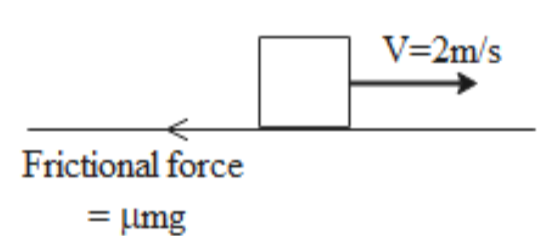Question
Question: A body of mass 2 kg is being dragged with a uniform velocity of \(2m{s^{ - 1}}\) on a horizontal pla...
A body of mass 2 kg is being dragged with a uniform velocity of 2ms−1 on a horizontal plane. The coefficient of friction between the body and the surface is 0.2. Work done by applied force in 5 s is (Take g=9.8m/s2)
A). 39.2 J
B). 9.32 J
C). 23.9 J
D). 93.2 J
Solution
Hint: The work done by an applied force is equal to the product of the force applied and the displacement produced in the body. The force here is due to the friction between body and the horizontal plane and for displacement we have value of velocity and time taken.
Formula used: F=μmg , d=v×t, W=F×d
Complete step- by- step solution:
Frictional force is a force which comes into action when two bodies slide over one another. This force is large when the surfaces are rough and small for smooth surfaces. The amount of friction that a surface exhibits can be characterized by what we call a coefficient of friction.
Coefficient of friction is defined as the ratio of the frictional force between two surfaces and the force that is keeping in contact with each other. The expression for frictional force is
F=μmg where μ is the coefficient of friction and it is dimensionless and does not have any units.

When a force is applied on a body, it gets displaced if the applied force is greater than the frictional force between two bodies. The displacement of a body is given in terms of its velocity and time interval as
d=v×t
We are given:
m = 2 kg
v = 2ms−1
μ=0.2
t = 5 s
g=9.8m/s2
Work done = Force x displacement
W=F×d
Substituting various values, we get
W=μmg×v×t ⇒W=0.2×2×9.8×2×5 ⇒W=39.2J
Therefore, the correct answer is option A.
Note:
1. The units must be in the same system.
2. In practical applications, friction is always there between two bodies and F=μmg is used as a general expression. F = mg is considered a special case when there is no friction between bodies and coefficient of friction is equal to 1.
